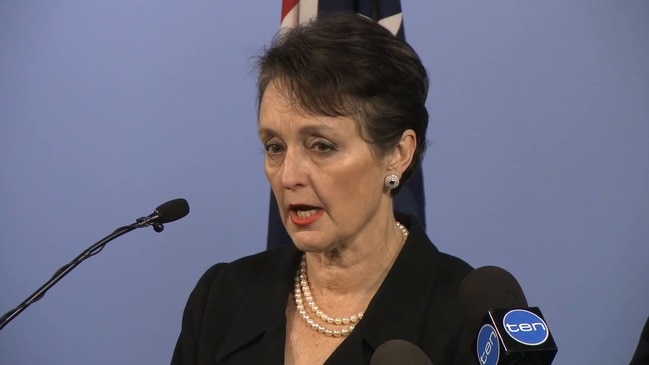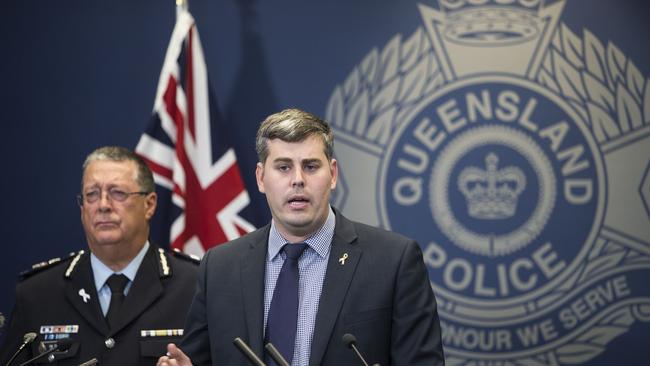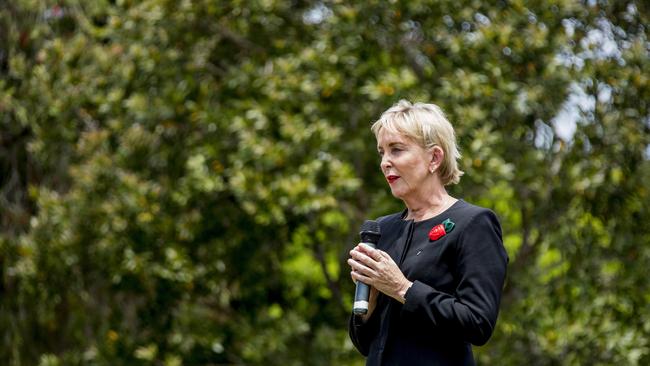DV thugs monitored from London as Bulletin obtains safety answers about tracking system
THE Queensland Police Service has finally revealed several potentially fatal flaws in the GPS tracking devices placed on domestic violence thugs — including their being monitored from overseas.

Crime and Court
Don't miss out on the headlines from Crime and Court. Followed categories will be added to My News.
THE Queensland Police Service has finally revealed several potentially fatal flaws in the GPS tracking devices placed on domestic violence thugs.
After sustained pressure from the Gold Coast Bulletin, the QPS was forced to respond to questions about the ankle bracelets, last night revealing:

● Offenders are being monitored by a private operator in the United Kingdom.
● Details about the staffing arrangements and whether the monitoring was 24/7 could not be divulged due to “commercial in confidence”.
● London consultants would contact the alleged thug and tell them to recharge the batteries on their bracelets.
● Not all offenders are subjected to prohibited areas, some may only be as a condition of bail and can remain just 100m from a victim’s home.

● An individual will only come to the attention of the monitoring centre when an alert triggers — i.e., the battery is running low, or for a breach, for example, cutting off the tracker.
● Victim is not monitored if they move out of an alleged offender’s no-go zone.
● GPS operates in near real time.
● When network access is unavailable, the device cannot communicate the location of the tracked person.
On Tuesday, Police Minister Mark Ryan maintained the ankle bracelets were “monitored around the clock, every second of the day”.

Top criminal lawyer Bill Potts yesterday challenged him to prove the trackers “are in fact being monitored by real people in real time”.
NEVER MISS A MINUTE WITH THE GOLD COAST BULLETIN APP
Mr Ryan yesterday declined to answer the Bulletin’s 15 questions about the tracking system, deferring the newspaper to Queensland Police.
The Minister’s office said the “detailed and specific nature of your questions” meant Queensland Police media would provide the responses.
The Bulletin was referred to Mr Ryan’s speech before Question Time yesterday where he defended the GPS tracking system for offenders.

“A very angry Police Commissioner has told me that recent claims about GPS trackers on the Gold Coast are wrong, ridiculous and reckless,” Mr Ryan said.
Commissioner Ian Stewart had described the GPS tracking system on the Coast as world class and represented best practice, which was why it was used by many public safety agencies internationally.
PERPETRATORS ASKED TO COME BACK IN 7 DAYS FOR GPS BRACELET
“The commissioner has also confirmed yet again that the trackers are monitored in real time every second of every day,” Mr Ryan said.
“That is not an opinion. It is not a claim. It is a fact. If someone with a tracker attached to them ventures into a no-go zone or breaches a curfew or tampers with their tracker, an alert is immediately sent to police.

“The commissioner says if an alert of this type is raised police act swiftly, within minutes.”
Mr Ryan said the Commissioner had also confirmed that if a Coast-based magistrate orders a tracker for a person then that tracker could be delivered within hours.
“Let us be clear, because the Bail Act is clear. It is only after a court has granted bail that consideration of a tracker takes place. In other words, these people will be on bail regardless.
“What our government has done is introduce an extra layer of monitoring of people if the court determines they need it. The laws that support these procedures began in March this year.”
THIRD MAN FITTED WITH GPS TRACKER ON GOLD COAST

However, neither Mr Ryan or Commissioner Stewart could not answer if victims were protected if they ventured outside of the no-go zones listed as part of alleged offender’s bail conditions; if attackers were being watched and not monitored; and why accused thugs had to remain in custody for at least three extra days, at taxpayers’ expense, because the trackers had to be transported from Brisbane.
Opposition MPs heckled Mr Ryan during his speech and accused him of hiding behind the courts.
“Labor’s embattled Police Minister is clearly out of touch and needs a reality check on GPS trackers,” Mudgeeraba MP Ros Bates said.
“We want these GPS trackers to be located on the Gold Coast because vulnerable domestic violence victims and their kids need more protection from high-risk offenders.
“The Minister can blame the courts and blame the lawyers all he likes but the buck stops with him as Minister.
“Community safety should be his number one priority and he needs to start listening to the Gold Coast community.
GET FULL DIGITAL ACCESS FOR $3 A WEEK
“Annastacia Palaszczuk needs to show some leadership and stop treating Gold Coasters like the poor cousins of Brisbane.
Opposition leader Deb Frecklington last night put forward a motion of notice which called on the Government to scrap an “absurd policy” which enabled DV perpetrators to have 10 extra days of taxpayer-funded leave.
Gaven MP Meaghan Scanlon described the move as a “cheap political stunt” and warned that authorities believed it was wrong to isolate and demonise offenders.
She said DV support groups maintained the two red flags for violence was “loss of income” and possibility of losing a family home.
After the motion was lost following a vote, Southport LNP MP Rob Molhoek told the Bulletin: “I’d rather see taxpayer funds spent in more crisis accommodation for victims.”
THE QUESTIONS WE ASKED — AND QPS ANSWERS:
(1) Which department is responsible for the policing of domestic violence offenders wearing GPS tracking devices? Corrections or Police?
It is the Queensland Police Service (QPS).
(2) Where are these offenders being monitored from? Is it from an office in Brisbane?
They are monitored from the United Kingdom.
(3) Is it the case that a private operator is responsible for the monitoring of offenders? Can the Government confirm that?
They are monitored by a private operator in the United Kingdom.
(4) How many people are employed monitoring the offenders? Is this conducted 24/7?
The monitoring service is contracted to an external provider. Their staffing arrangements are commercial in confidence.
(5) What is a no-go zone? Can the Minister give an example? Is it limited to an area like a suburb where the aggrieved lives, shops, takes their children to school?
Defendants on bail are subject to a (GPS) tracking condition supported by other conditions relating to prohibited areas — that is, areas they are not permitted to enter as part of their bail undertaking.
Prohibited zones are mapped by a series of geometric points around a location and recorded within the monitoring system.
An alert occurs when a tracked person’s location is found to be within this geo mapped prohibited area. Not every person with a tracking condition need be subject to prohibited areas. It will depend on the individual bail conditions. Others, however, may have conditions imposed that stipulate they are to remain outside a particular radius of a location — for example, 100m from a victim’s residence.
GPS technology is designed to track a person across time and space. It operates on the principle of ‘geo-fencing’, which entails the programming of multiple and potentially unlimited zones of exclusions (areas an individual cannot go) and inclusion (areas an individual cannot leave).
(6) Is it correct that the GPS tracking device will trigger an alarm only if the offender
enters a no-go zone area?
No, there will also be an alarm if the device is tampered with removed or the individual enters an interest zone.
(7) What happens when an offender needs to the charge the batteries of the GPS tracking device? Is it the case that the offender, during such a period, could with assistance, be taken and moved into a no-go zone without the monitoring centre being aware of it?
One of the conditions in a bail undertaking creates an obligation for the defendant to ensure the device battery remains charged. An alert will activate when a battery is running low. At this time the monitoring centre will contact the defendant and instruct them to recharge the battery. In the event the individual does not comply, an alert will trigger again. Failure to charge the device is a contravention of the bail condition.
(8) How many offenders have entered a no-go zone and an alert was sent out?
As of September 5, 2018, only one person on bail has been detected breaching a prohibited area condition. The external monitoring centre notified the QPS and the defendant was subsequently arrested and charged with breach of bail. He was returned to custody by the court.
(9) What were the repercussions for offenders entering a no-go zone, having sparked an
alert?
Police are notified via Policelink or the Communications Centre and a police response occurs through usual priority arrangements appropriate to the circumstances. Entering a prohibited area is a contravention of a bail condition for which the individual may be arrested and charged.
(10) Was there 24/7 monitoring of an offender’s whereabouts after sparking an alert?
The monitoring service automatically monitors all persons subject to GPS tracking 24/7. However, an individual will only come to the attention of the monitoring centre when an alert triggers — either for a technical reason (i.e., the battery is running low, or for a breach, for example, cutting off the tracker).
(11) What happens if the victim moves out of the no-go zone? Are they still protected then?
For GPS to detect a separation zone breach, it must be able to obtain, track and record the location of both a victim and perpetrator simultaneously. The current arrangements do not provide for a victim to be monitored.
(12) Is the case, as a leading lawyer has explained, that the devices are not being monitored in real life in real time, in others words — the reality is offenders are not being watched?
GPS operates in near real time. Tracking information is subject to series settings — the more frequent the location is fixed, the shorter the battery charge.
(13) Is this system under review?
The QPS committed to review the arrangements consistent with continuous review and improvement of all police systems and practices.
(14) Can you please explain why information on accused criminals is going back to the UK before being bounced back to police here?
The monitoring service provider is physically located in the United Kingdom. As a global electronic system, components can be located in several different locations.
(15) What happens if coverage on the 3G network fails? There are black spots on the Coast
like Coomera for mobile phone coverage. These same areas experience high level of complaints about domestic violence — what happens if the system fails there?
For GPS monitoring to operate to optimal conditions it requires access to GPS coverage (satellites) and for the device to be within an area serviced by the 3G mobile network. When network access is unavailable, the device will not be able to communicate the location of a tracked person to the monitoring service until the connection is reactivated. GPS tracking (electronic monitoring) for bail offenders is merely an additional tool for persons who have already been considered suitable for release on bail by the presiding court. Individuals subject to a tracking condition are already assessed as not presenting an unreasonable risk to the community as part of the bail consideration process. High risk offenders are, by definition, not granted bail.


